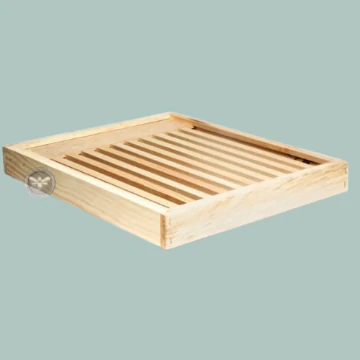For those who are into beekeeping, a slatted rack can be a handy tool to have in their Langstroth hives. This optional piece of equipment is often used by beekeepers to help regulate the temperature and humidity inside the hive. The rack, sometimes referred to as a brood rack, is about two inches high and is carefully placed between the bottom board and the lowest brood box. By creating a space between these two areas, the bees have more room to move around and can circulate air more efficiently, keeping their hive at a comfortable temperature. The slatted design of the rack also allows for better ventilation and drainage, which can help prevent moisture buildup and reduce the risk of disease in the hive.
A standard Langstroth hive and the rack are identical in terms of their external dimensions. The newer version has ten slats that run parallel to the frames located in the brood box with gaps between each one. It’s typical for it to have a board that’s 4 inches broad, running alongside the hive’s front portion. Hobby hives often feature slatted racks while commercial ones rarely do.
What does a slatted rack do?
If you’re curious about the function of a slatted rack, it’s worth noting that this nifty device serves a key purpose in beekeeping. Essentially, a slatted rack is a piece of equipment that is positioned below the brood chamber in a beehive. The purpose of a slatted rack is to provide dead air space between the bottom of the brood chamber and the floor of the hive. This layer of air helps to keep the colony cooler in summer and warmer in winter, which can ultimately lead to healthier colonies and more productive hives. So, whether you’re a seasoned beekeeper or just starting out on your journey, it’s important to understand the various tools and techniques that can help you keep your bees happy, healthy, and thriving.
Honey bees tend to avoid crowding the nest in summer to avoid overheating and prevent developing brood. They may opt to “beard” on the hive’s front or below its stand. But by installing a slatted rack, adult bees have enough space to gather inside the hive without disrupting the brood area. The availability of extra space allows for better fanning, thereby enhancing ventilation and promoting honey curing processes as well.
What is its purpose?
Some people believe that the purpose of a slatted rack is to reduce bearding, while others believe it can help relieve overall congestion. I love climbing under my hives on a hot day and watching all those bees congregate on the rack! During the winter season, when the entrances are limited and varroa boards are set up, utilizing a slatted rack creates an insulation barrier that keeps a layer of air between the brood nest and outer environment. Moreover, it also shifts the brood nest away from the chilly and breezy hive entrance.
The laying of eggs near the hive entrance by a queen may be hampered due to changes in air temperature. By employing a slatted rack, the lower combs can be shifted away from the entrance, resulting in an expansion of available space for brood-raising purposes.
When do you install the rack?
A slatted rack is a tool I often utilize and keep in position all-year-round. I set it up at the start of a new hive, even with a nuc, and refrain from removing it entirely.
In my previous statement, I mentioned their non-compulsory nature. While they increase the cost and overall size of a beehive, I personally have an affinity towards them and view them as a necessary component of a customary arrangement. Despite some apiarists advocating for universal implementation of slatted racks as conventional gear, it is not currently widely accepted. Henceforth, my suggestion would be to test one out yourself to determine its effectiveness in your own setup.
When it comes to beekeeping, slatted racks are an essential component for a healthy hive. Luckily, most bee supply companies offer these racks fully assembled and ready to use. However, before placing it above the bottom board, I like to take the time to sand and paint the outside. Not only does this help protect the wood from the elements, but it also adds a personal touch to my beekeeping equipment.


